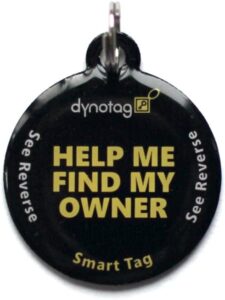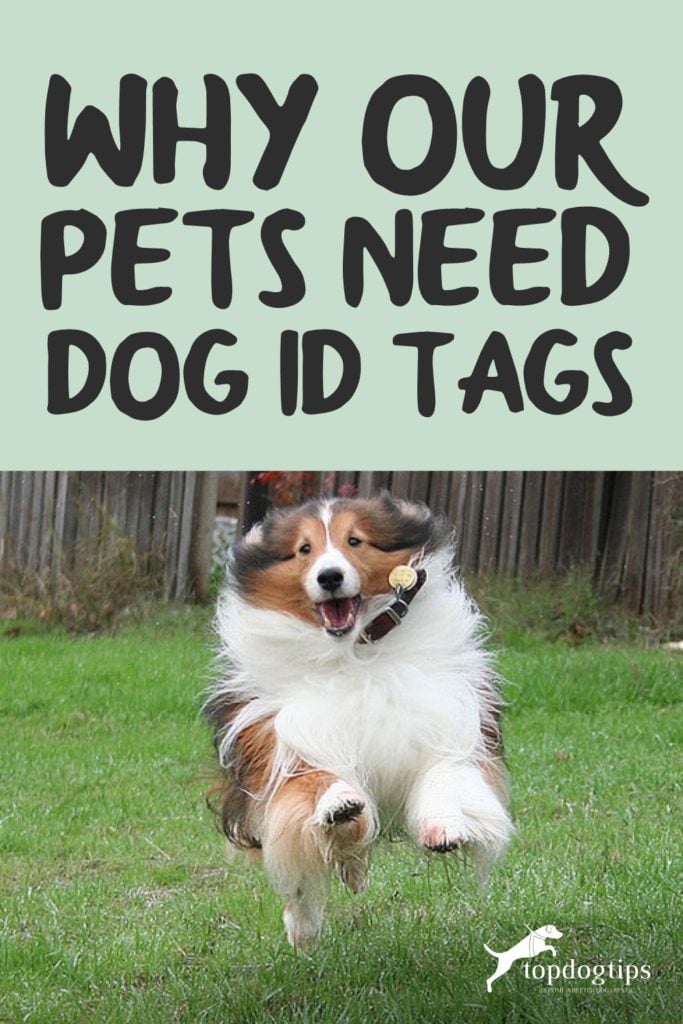
Table of Contents
Few things are worse for a pet owner than a runaway dog.
Even more terrifying than that is a runaway dog that can't be found.
America's kennels house millions of dogs annually, many of which are runaways.
With the help of microchipping and pet identification tags, some of these dogs can be returned to their rightful owners and homes, but not before the owners suffer emotional stress and have to pay a fee to retrieve their dog from the shelter.
The risk of losing your loved one is the main reason your dog needs a pet ID tag, but it isn't the only one.
Having an ID tag on your dog's collar at all times is beneficial to you, your pet, and anyone that may come across them while they're lost.
As pet owners, we take responsibility for our dogs and do everything we can to protect and care for them responsibly.
Equipping canines with a dog ID tag is a cheap and easy way to do just that.
In 2012 there was a first published national study on lost pets conducted by the American Society for the Prevention of Cruelty to Animals (ASPCA), and the results are surprising.
According to the study…
Only 6% of dog owners and 2% of cat owners found their lost pets at shelters.
Sadly, many of those runaway animals were never found, and the ones that were found were either tracked down by the owners themselves or located by a good Samaritan.
If your dog ran away or somehow got lost, and a stranger has found her, how would they know who to return her to?
If she isn't wearing any kind of identification with your contact information, she will likely end up being dropped off at a shelter or taken in by another family.
If your dog runs away, the most important thing to do is to stay calm.
Dogs run away very often, and they do so for many different reasons; it isn’t necessarily something you should take personally.
Your Fido might be bored, lonely, or curious.
If you have an outgoing dog, she might want to see if there are other dogs she can play with.
It isn’t a sign that you’re a bad owner—unfortunately, dogs just run away; it happens.
Why Your Dog Needs a Pet ID Tag?
Simply put, finding a runaway dog can be a thousand times easier if you put a pet ID tag on her.
A similar study by the National Council for Pet Population (now AAWA) reports that only 15-20% of lost dogs are returned to their owners.
This study doesn’t reflect a population unwilling to help pet owners.
It indicates that people don’t identify their dogs properly, making them impossible to be returned.
In addition, HumaneSociety.org provides the number of adoption of the same lost pets, and it's not pretty:
An estimated 2.7 million healthy shelter pets are not adopted each year, and only about 30 percent of pets in homes come from shelters or rescues.
There's no question that pets get lost and that not all of them are returned.
This is the primary reason why all canines should wear pet ID tags.
To make those dog ID tags useful, you need to include all the information that someone would need to contact you.
It's important that you keep this data updated at all times.
Unlike most other dog supplies, pet identification tags aren't expensive and easily replaced.
You can purchase them through countless online retailers and at most pet stores.
Grab a few so that you have them whenever you need them.
Dog owners who love to keep their pets in style have a variety of options to choose from.
Top 5 Best-Selling Dog ID Tags on Amazon:
- 8 Shapes & Colors
- GoTags Stainless Steel Pet Id Tags
- Anodized Pet ID Tags
- GoTag Slide-On Pet ID Tags
- Round Pet ID Tags
Quick tip: Buy more than one tag and keep them current. If your information changes, be sure to update your dog's tags.
What to Put on My Dog's Pet ID Tag
Names and phone numbers aren't the only information you should put on a dog ID tag.
Think about what you would want a stranger to know about your pup.
If you left her in the care of a new person, what are the first few things you would tell them?
That's the kind of important information that must be included on your dog's identification tags.

Do include your dog’s name on the tag.
It sounds obvious, but many people forget about this part.
It is helpful for the person who finds your dog to know your Fido's name.
When a stranger tries to entice her to come with him or her and develop trust, they’ll have an easier time of it if they know the dog's name.
Also, it will make your dog feel more comfortable and less afraid if the person they are with knows or uses your pet's name.
RELATED: 10 Items You Need When Traveling With Dogs
Goes without saying, you should put down your name and contact information, including your phone number and address.
Although you might be skeptical about disclosing personal information on the pet tag, remember that your dog’s life is potentially at stake.
Smartphones are taking over our modern world, and thanks to them, you can use a simplified version of a pet ID tag – Dynotag.
However, not all pet owners trust the new technology, and many still opt to go old school.
If you're one of the latter, remember to include all the vital information about your dog on the tag.
Be sure to list all pertinent stuff, such as:
- Medications
- Allergies
- Serious medical conditions
- Health needs
- Special diet requirements
- Your veterinarian's name and clinic
- Age/year of birth
Add anything that would be important for someone to know who has never met your dog before.
A person’s urge might be to feed your dog a treat while they try to get in touch with you.
If your dog has a serious allergy, this could be dangerous.
Placing pertinent information on the ID tag reduces the risk that your dog could run into medical complications after she is found.
If you're passionate about protecting your dog from becoming lost, I wrote an article on a related topic last week: Dog Safety: This is Why Your Dog Needs a GPS Tracker.
“Why Does My Dog Need ID Tags if I Can Just Buy Her a Gps Tracking Collar?”
Smartphone-based trackers are an excellent way to find lost pets, but what happens if you're not in the cell tower range and your tracker isn't working?
What if the batteries die?
What if your dog gets too far away and is out of range?
Equipping your GPS tracking collar with identification tags is the only way to ensure that whoever finds your dog will know how to contact you.
How to Use a Pet ID Tag on a Dog?
Putting a collar on your dog with an identification tag is the most common way to ensure it stays in place.
Note that you may have trouble with your pet when you attempt to strap a collar on her.
Occasionally, dogs don’t like the feeling of a collar around their neck and may get irritated when forced to wear one.
Introduce the collar gradually to your pet so that even if she finds it disagreeable, she will slowly come to accept it.
Keep it on her for short periods of time at first, and then prolong the time period slowly over the course of a few days.
The rule of thumb is that if you can fit two fingers side by side underneath the collar, then it is well-fitting.
 Breakaway collars are a good idea to purchase (pictured above).
Breakaway collars are a good idea to purchase (pictured above).
These dog collars are similar to childproofing measures and will release the dog if the collar gets hung up on something.
This decreases the risk of dogs accidentally asphyxiating themselves or damaging their neck.
It's often been used as a main dog training collar with hunting dogs and is now becoming prevalent among many pet owners for regular use.
RELATED: Ten Unusual Dog Products Pet Parents Buy
What Happens if Your Dog Actually Gets Lost?
When the worst-case scenario does happen, and a canine is lost, no responsible dog owner will want just to sit back and wait for someone to find their pet.
A dog ID tag is an excellent measure to take in the event of a runaway dog, but when it actually happens, there are more variables of this situation that you should take into consideration.
The first thing any owner will do when a dog goes missing is run out to search frantically.
Sometimes that works; sometimes, that’s not enough.
It’s important to “search smart” when attempting to find a lost dog.
If you keep your wits about you instead of panicking, your search will go smoother, more quickly, and ultimately yield better results.
Always keep your phone on you and have someone back at your house if a good Samaritan responds to the ID and tries to contact you to return your lost pet.
Take into consideration the size and physical capability of your pet.
If it’s a large, fast-moving dog, it can go pretty far.
Smaller dogs like Pomeranians and toy Poodles are less likely to drag you out on a miles-long search.
Estimate the spot where the dog ran away and draw a radius out from there to calculate how many miles it could have gotten in the span of time it has been gone.
Search that region again and then expand outward from there.
Another key thing to do is to spread awareness that the dog has been lost in the first place.
Hang posters with contact information and as many pictures of your dog as possible.
People want to help, and if you give them enough information, someone is bound to turn up with something.
We've seen this happen numerous times.
 There are a lot of smartphone pet apps available now to help dog owners find their lost pets.
There are a lot of smartphone pet apps available now to help dog owners find their lost pets.
For more information on these pet apps, you can browse our related News section, including the below articles:
- Google and Pedigree Team Up to Find Lost Dogs
- Where's Nellie Pet Locator App Launching with the Help of Kickstarter
- PetHub Helps Owners Track Down Lost Pets
Don’t give up too soon.
Losing a pet is heartbreaking, but you must be very persistent in your relocation efforts to find your dog.

Although you may be angry and scared with a whole mix of other emotions, you should not punish your dog for what she's done when she finally returns home.
If you do, that will give the dog the impression that returning home means punishment.
Instead, pet your dog and give her praise, playtime, and treats.
This way, she will associate returning home with positive rewards.
Making the concept of coming home (even after doing something bad like running away) a fun one will strengthen the bond between you and your pet.
It cannot be stressed enough how important putting a pet ID tag on your dog is to the safety and security of a canine and a piece of mind for the owner.
It is the ultimate safety net if your dog decides to run away.
You can buy them at the pet store or even have them custom-made online for a fee.
Think of a pet ID tag as an inexpensive form of insurance for your runaway pets' safe return.
Want To Share This…
Disclosure: We may earn affiliate commissions at no cost to you from the links on this page. This did not affect our assessment of products. Read more here and find full disclosure here.


















